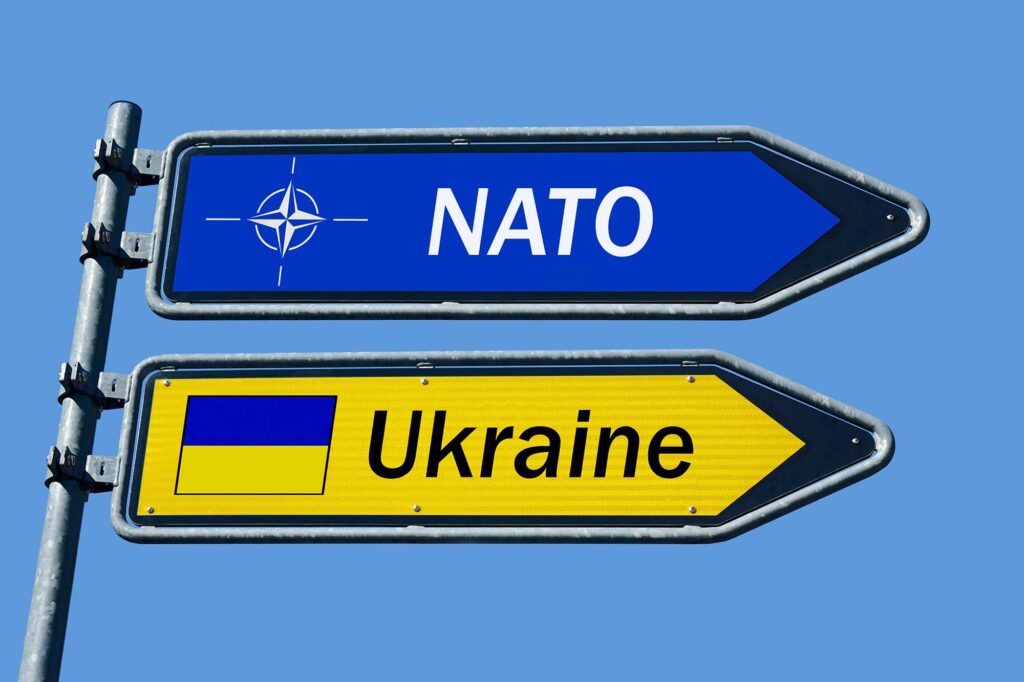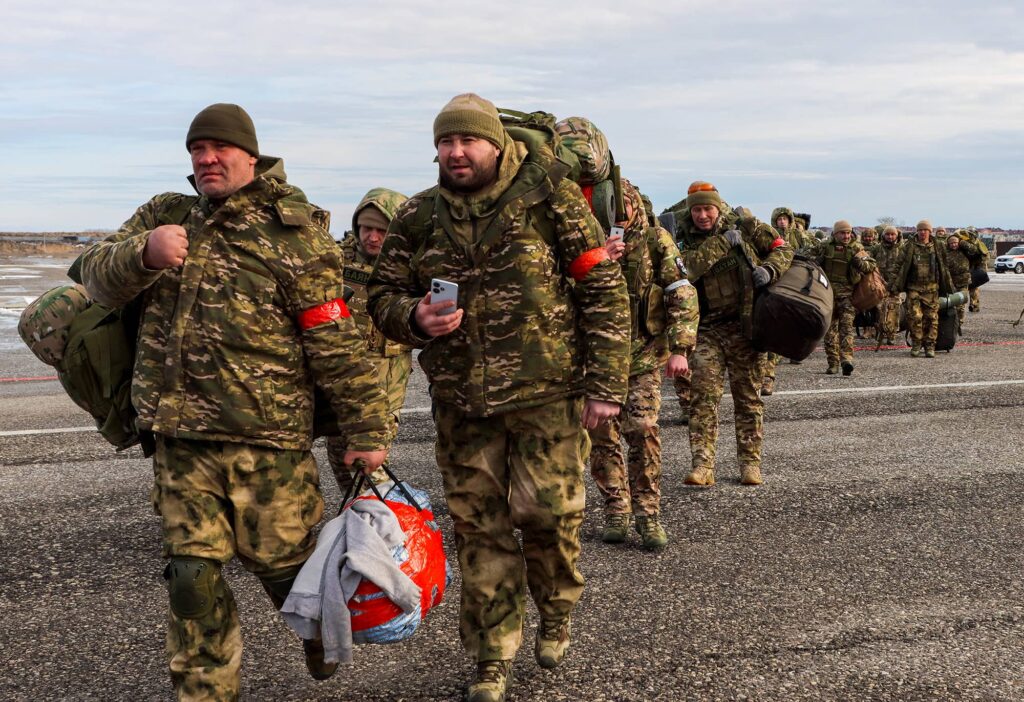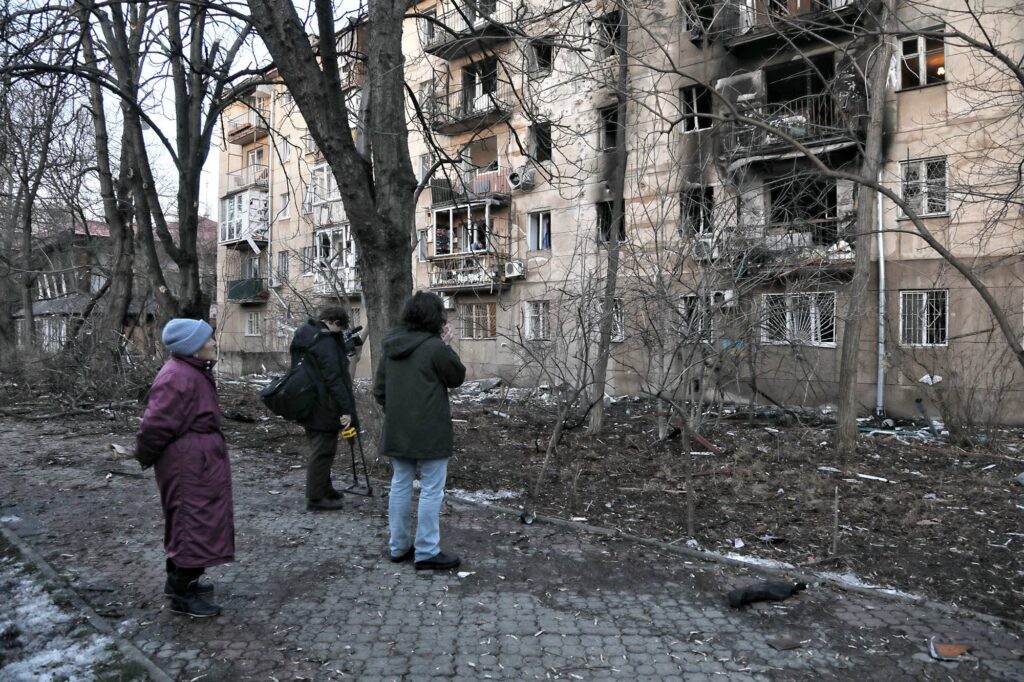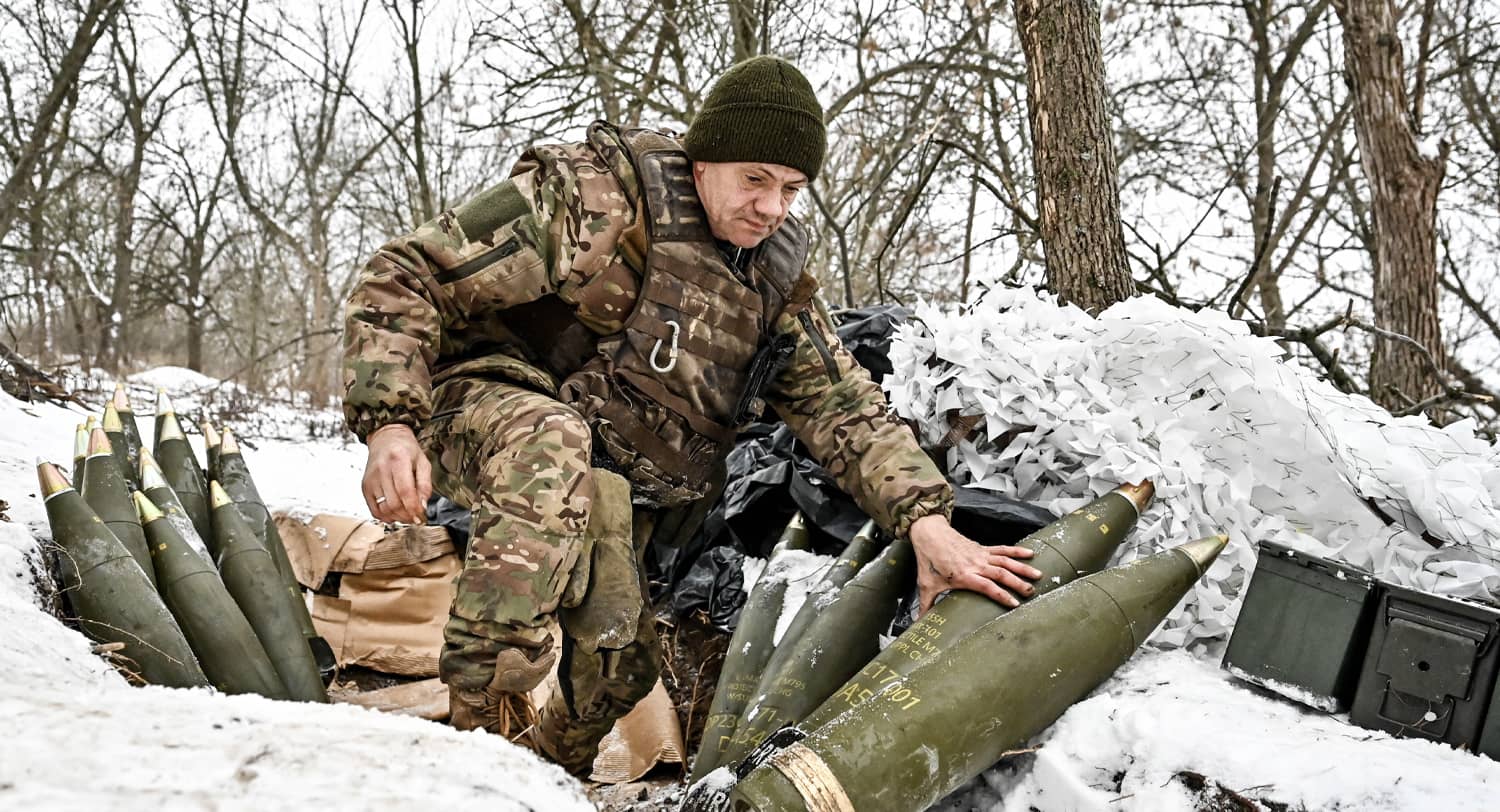As the war approaches the end of its second year, unless some dramatic development occurs to shift current trends – for instance, a collapse of NATO support for Ukraine or the death of Putin – it seems that the war is a long way from being decided or brought to an end. Initial lessons on the military side are already available.
Russia’s Evolving War Goals
Two years ago, before the war in Ukraine started, Russia’s political goals were to return Ukraine to the Russian sphere, prevent it from ever joining NATO and tie its foreign policy and economy with those of Russia. A secondary goal was the return to Russia of areas of Ukraine that Russians regard as historically Russian and that only became part of Ukraine because of the manner in which the Soviet Union drew its internal maps.
To achieve these goals Russia’s invasion was organized in two major directions:
A converging thrust directly towards Kyiv – a special forces ‘scalpel’ aimed directly at the Ukrainian political leadership, followed by a larger, but still fairly small airborne force to reinforce it and a large ground force to stabilize the new regime that would replace it. This was similar to the operations launched against Hungary (1956), Czechoslovakia (1968) and Afghanistan (1979).
A dispersed offensive across eastern Ukraine to capture most of it with an auxiliary thrust also along the Black Sea coast towards Odessa, utilizing Russian control of Crimea since 2014.
The early Russian offensive towards Kyiv gained much territory, but did not achieve its political goal of eliminating the Ukrainian regime. Simultaneously, the offensives in eastern Ukraine captured a sizable area, although the attempt to advance towards Odessa was defeated.
The Russians assumed that a majority of Ukraine’s population would either support or be indifferent towards the notion of Moscow imposing a pro-Russian regime in Kyiv. This was a major intelligence failure that led, among other things, to the Russians deploying a force too small to achieve the goals assigned to it – both the force-to-pace ratio, and the Russian force to Ukrainian force ratio. In both cases, the invading force was in many respects weaker than the Ukrainian forces facing it.
After the failure of the offensive towards Kyiv, Russia’s political focus shifted and the secondary political goal, “liberating” historically Russian territory, became the primary goal. Not for the last time in this war, Russian leadership exhibited an ability to cut their losses and recalibrate their goals to their perceived capabilities.
Ukraine’s Evolving Goals
Initially, Ukraine’s political goal was merely to survive the Russian onslaught, maintain its political independence, and not lose more territory, in addition to that already lost in 2014. The defeat of Russia’s thrust towards Kyiv, especially when followed by its withdrawal of forces from that region, and the slowing down of Russia’s offensive in eastern Ukraine, encouraged Ukraine’s leaders to believe that they could also recover the territory lost in the first half year of the war.
Ukraine’s first major counter-offensive, launched in late August 2022, did indeed regain some ground. East of Kharkiv, Russian troops rapidly abandoned a few thousand square kilometers of ground and much equipment before finally regrouping to halt the Ukrainians. Russians gave up more ground around Kherson (another deliberate cutting of losses). This success caused the Ukrainians to extend their goal from the liberation of all the territory lost in the initial Russian 2022 invasion to the liberation of the territory lost in 2014. Russian attacks through the winter of 2022 – 2023 regained some ground (especially the town of Bakhmut) but at an enormous cost that seemed to show that the Russian army was indeed weak and could possibly be defeated by another major counter-offensive.

NATO’s Evolving Goals
NATO, which according to some sources was surprised by the initial Russian failure, backed Ukraine’s original goals but seems to have been less enthusiastic about the extended goals. NATO is chary of pushing Russia to the point that Putin might feel the need to employ nuclear weapons in order to prevent a defeat too great for the survival of his regime (after he claimed that the annexed regions are now Russian national territory).
NATO supplied crucial funding and equipment for Ukraine to survive, but not enough to defeat Russia decisively. Partly this was because of the hesitation to provoke Russia. But another reason was that NATO simply could not keep up with the demands of the war. The weakness of NATO countries’ defensive organizations – the militaries themselves, the military industries and the political and legal structures providing support – was exposed.
The war also exposed the limitation of sanctions as an economic weapon of NATO. Sanctions imposed on Russia by NATO states caused some damage to Russia’s economy (though how much is disputed by economic analysts) but did not deter Russia from prosecuting the war. Furthermore, the sanctions on Russian oil also damaged the economies of NATO members – causing a slow imposition of sanctions, allowing Russia to adjust (thus, for example, creating a global shift in the direction of oil exports and the creation of bypass routes of trade between Russia and Western countries). To the unpleasant surprise of the NATO leaders, much of the non-NATO world refused to respect these sanctions, let alone impose them. The current discussion on whether to transfer Russian Central Bank funds frozen in Western banks to Ukraine may strengthen a trend away from the US dollar-based international trade regime towards an alternative Chinese-dominated trade regime.
Russia Strikes Back in 2023
Following its reversal in the Ukrainian autumn 2022 counter-offensive, Russia realized that maintaining its mobilization and military industrial output at peacetime levels was one of the reasons for its defeats. The response was to mobilize approximately 300,000 reservists, reduce exemptions from conscript service and launch a patriotic and fiscal campaign to encourage volunteering to the armed forces. Another source of volunteers was imprisoned criminals serving long sentences who were promised release in return for service at the front. The first batch of newly mobilized personnel reached the front with minimal training to rapidly close gaps at the front, the others received longer and better training before being sent forward. Russia’s industry was ordered to shift focus to meet military requirements.
Military industry output takes longer than mobilization of new manpower. Meanwhile Russia turned to external vendors to close gaps in its arsenals – Iran, North Korea and China. Iran, specifically, provided a solution to a technological gap suffered by the Russian forces – a variety of exploding drone models for strategic and tactical uses, and the technology to manufacture them in Russia.
Though the Russian army resumed localized offensive operations through the winter of 2022 – 2023, it focused on preparing a strong defensive front for the expected next Ukrainian counter-offensive, building several lines of obstacles and fortifications, and deploying forces to close gaps, create depth and mobile reserves – in short, falling back upon the foundations of Russian defensive doctrine.
The Ukrainian counter-offensive began in May 2023 with long-range firing at Russian command and logistics followed by a ground offensive in early June. The counter-offensive failed after only miniscule gains on the ground and heavy losses on both sides. Already during the Ukrainian attacks the Russians renewed their own deliberate slow but steady offensive, initially on secondary fronts and gradually also in the areas where the Ukrainians had attacked and gained ground.
As of the end of 2023, the Russian counterattacks have gained more ground than the original Ukrainian achievements.

The failure of the Ukrainian counter-offensive has also weakened the resolve of NATO to support Ukraine. There are more open calls for reaching an accommodation with Russia and demands to limit the funding and supply of equipment. NATO’s flow of equipment and ammunition is not sufficient and Ukrainian units are feeling the lack of it as they are forced to give ground. Part of the problem is that the production rate of equipment and ammunition is still well below that needed by the Ukrainian forces. It is too early to tell whether these voices will create a crisis in NATO support and actual pressure on Ukraine to accept a completely unfavorable compromise with Russia.
Both sides are hiding their casualty data but both have suffered casualties in enormous proportions. Though the Russians seem to have lost more, the casualty ratio is not enough to amount to a Ukrainian victory – the ratio of available manpower in Russia’s favor is greater. Furthermore, the duration of the war and the accumulation of casualties is beginning to sap the morale of Ukraine’s population. The initial fervor and voluntary mobilization is over; conscription is facing more resistance and evasion. Ukraine’s leaders are discussing widening the conscription to add age groups that were previously exempt and imposing sanctions to compel Ukrainians living abroad to return to serve. These actions shine a light on the level of casualties suffered by the Ukrainian forces.
The War at Sea and in the Air
The land war at the front and industrial output in the rear will be the ultimate arbiters of this war, but two secondary fronts also demand attention.
At sea, Russia initially enjoyed complete supremacy – its navy imposed a maritime blockade, launched numerous missiles and conducted some amphibious operations. However, gradually the Ukrainians have managed to erode that supremacy with a sea-denial strategy based on a long-range fire capability built during the war. Aerial drones, shore-to-sea missiles and long-range exploding drone-boats have forced the Russian navy to distance itself from Ukraine’s shores. This has enabled a bypass of the naval blockade and reduced the threat of amphibious landings while simultaneously enabling the Ukrainians to conduct some naval-commando raids.
In the air, the Russian initial one-way war against the Ukrainian hinterland has evolved into a two-way exchange. Though the Russian air force is much bigger than Ukraine’s, it had never developed a non-nuclear strategic bombardment capability and is almost incapable of penetrating Ukrainian air defenses. Instead it reverted to the use of long-range missile and exploding drones and a large proportion of these, too, are being shot down. Russia still enjoys an advantage in its ability to bombard Ukraine’s rear, but at its height, even before Ukraine received the weapons necessary to defend itself, Russian capability was never enough to cause damage at a level that would bring Ukraine to its knees – especially as Ukraine’s economy and military industry rest on NATO support rather than its own resources.

Russia’s missile and exploding-drone campaign have proven both the weakness of these tools in a strategic bombardment role, and the Russian limitations in the number it can launch simultaneously. Ukraine’s attacks on Russia’s rear are much weaker, however, and serve mainly as harassment designed to gain propaganda points.
Except for attack helicopters, which suffered heavy losses, Russian tactical air support for its ground forces was almost completely absent in the initial months of the war but gradually increased, adding new weapons such as precision-guided bombs of which it had very few at the start of the war. Ukraine’s tactical air support was almost completely dependent on missile-launching drones. These were celebrated in the first few weeks of the war as very successful and then disappeared from view, as Russia deployed anti-aircraft systems that rapidly destroyed the majority of the Ukrainian drones.
Both sides have gradually shifted to smaller drones – shorter range, smaller payloads but more difficult to shoot down. Most of these are civilian drones improvised into weapons. They have proven to be capable weapons but, despite much enthusiasm in news reports, not battle-winners in themselves. Both sides have begun deploying electronic weapons to defeat these smaller drones, and seem to be achieving a fairly high rate of success. The available data reveals a relatively low target destruction rate compared to the numbers of drones sent to the front. The smaller drones are useful for surveillance and reconnaissance of the enemy or for control of one’s own troops.
Conclusion – the Role of Technology
A great number of modern technologies are being employed in this war – technologies that many theorists promised would create a revolution in warfare, making all previous military technologies and methods obsolete. Instead, what has happened is a merging of the new with the old with a clear emphasis on the old as determining the tactical and strategic results of battles. This is one of the reasons NATO is finding it difficult to provide Ukraine with what it argues it needs to win the war – NATO military industries had drastically reduced their ability to manufacture supposedly ‘obsolete’ hardware.
In some respects. the war in Ukraine resembles more the First World War – albeit with the inclusion of modern technology – rather than the revolution predicted by the military theorists. However, this resemblance should not be overstated. There are clear differences between the military capabilities of Ukraine and Russia on the one hand and those of NATO countries on the other. Had NATO militaries been directly involved from the start, their air power, much more capable than those of Ukraine and Russia, would have created a different model. Perhaps the Normandy campaign of the Second World War would have provided a closer analogy in that case – though Russia’s air defenses against modern air attacks, relative to those of Germany in 1944, are considerably more capable.
The war has demolished theories that originate in Western international relations institutions, whether academic or governmental, since the collapse of the Soviet Union, as to the state of the world and where it is headed. It has also demolished theories of the Western militaries – a version of which had also been developed in the Russian army, based on the supposed impact of a variety of modern technologies – especially on the centrality of cyber warfare, precision-guided munitions, and on small volunteer armies being sufficient to decide all wars. This is not the way things have turned out for either side in the Ukraine War.

